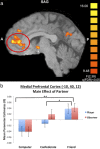Social network modulation of reward-related signals
- PMID: 22745503
- PMCID: PMC3412567
- DOI: 10.1523/JNEUROSCI.0610-12.2012
Social network modulation of reward-related signals
Abstract
Everyday goals and experiences are often shared with others who may hold different places within our social networks. We investigated whether the experience of sharing a reward differs with respect to social network. Twenty human participants played a card guessing game for shared monetary outcomes with three partners: a computer, a confederate (out of network), and a friend (in network). Participants subjectively rated the experience of sharing a reward more positively with their friends than the other partners. Neuroimaging results support participants' subjective reports, as ventral striatal BOLD responses were more robust when sharing monetary gains with a friend as compared to the confederate or computer, suggesting a higher value for sharing with an in-network partner. Interestingly, ratings of social closeness covaried with this activity, resulting in a significant partner × closeness interaction; exploratory analysis showed that only participants reporting higher levels of closeness demonstrated partner-related differences in striatal BOLD response. These results suggest that reward valuation in social contexts is sensitive to distinctions of social network, such that sharing positive experiences with in-network others may carry higher value.
Figures




Comment in
-
Interpersonal closeness and social reward processing.J Neurosci. 2012 Sep 12;32(37):12649-50. doi: 10.1523/JNEUROSCI.3157-12.2012. J Neurosci. 2012. PMID: 22972989 Free PMC article. No abstract available.
Similar articles
-
Beautiful friendship: Social sharing of emotions improves subjective feelings and activates the neural reward circuitry.Soc Cogn Affect Neurosci. 2015 Jun;10(6):801-8. doi: 10.1093/scan/nsu121. Epub 2014 Oct 8. Soc Cogn Affect Neurosci. 2015. PMID: 25298009 Free PMC article.
-
Differential reward responses during competition against in- and out-of-network others.Soc Cogn Affect Neurosci. 2014 Apr;9(4):412-20. doi: 10.1093/scan/nst006. Epub 2013 Jan 12. Soc Cogn Affect Neurosci. 2014. PMID: 23314007 Free PMC article.
-
Social Context and Reward Sensitivity Enhance Corticostriatal Function during Experiences of Shared Rewards.bioRxiv [Preprint]. 2023 Oct 19:2023.10.19.562908. doi: 10.1101/2023.10.19.562908. bioRxiv. 2023. PMID: 37905048 Free PMC article. Preprint.
-
Opposing BOLD responses to reciprocated and unreciprocated altruism in putative reward pathways.Neuroreport. 2004 Nov 15;15(16):2539-43. doi: 10.1097/00001756-200411150-00022. Neuroreport. 2004. PMID: 15538191
-
Shared understanding and social connection: Integrating approaches from social psychology, social network analysis, and neuroscience.Soc Personal Psychol Compass. 2022 Nov;16(11):e12710. doi: 10.1111/spc3.12710. Epub 2022 Oct 17. Soc Personal Psychol Compass. 2022. PMID: 36582415 Free PMC article. Review.
Cited by
-
Revisiting Psychological Mechanisms in the Anthropology of Altruism.Hum Nat. 2017 Mar;28(1):76-91. doi: 10.1007/s12110-016-9278-3. Hum Nat. 2017. PMID: 27796826
-
Neural reward-related reactions to monetary gains for self and charity.Cogn Affect Behav Neurosci. 2019 Aug;19(4):845-858. doi: 10.3758/s13415-018-00672-1. Cogn Affect Behav Neurosci. 2019. PMID: 30488227 Free PMC article.
-
Beautiful friendship: Social sharing of emotions improves subjective feelings and activates the neural reward circuitry.Soc Cogn Affect Neurosci. 2015 Jun;10(6):801-8. doi: 10.1093/scan/nsu121. Epub 2014 Oct 8. Soc Cogn Affect Neurosci. 2015. PMID: 25298009 Free PMC article.
-
The Role of Social Reward and Corticostriatal Connectivity in Substance Use.J Psychiatr Brain Sci. 2020;5:e200024. doi: 10.20900/jpbs.20200024. Epub 2020 Oct 29. J Psychiatr Brain Sci. 2020. PMID: 33215046 Free PMC article.
-
The Neurobiology of Giving Versus Receiving Support: The Role of Stress-Related and Social Reward-Related Neural Activity.Psychosom Med. 2016 May;78(4):443-53. doi: 10.1097/PSY.0000000000000302. Psychosom Med. 2016. PMID: 26867078 Free PMC article.
References
-
- Amodio DM, Frith CD. Meeting of minds: the medial frontal cortex and social cognition. Nat Rev Neurosci. 2006;7:268–277. - PubMed
-
- Aron A, Aron EN, Smollan D. Inclusion of the other in the self scale and the structure of interpersonal closeness. J Pers Soc Psychol. 1992;63:596–612.
-
- Behrens TE, Woolrich MW, Walton ME, Rushworth MF. Learning the value of information in an uncertain world. Nat Neurosci. 2007;10:1214–1221. - PubMed
-
- Delgado MR. Reward-related responses in the human striatum. Ann N Y Acad Sci. 2007;1104:70–88. - PubMed
Publication types
MeSH terms
Substances
Grants and funding
LinkOut - more resources
Full Text Sources
